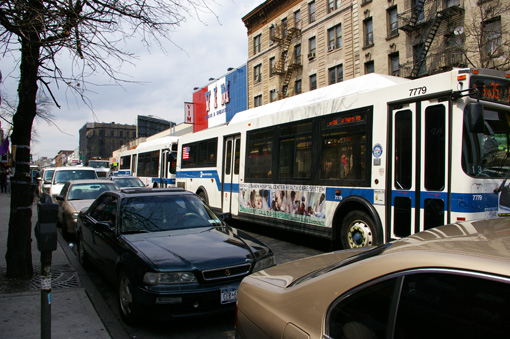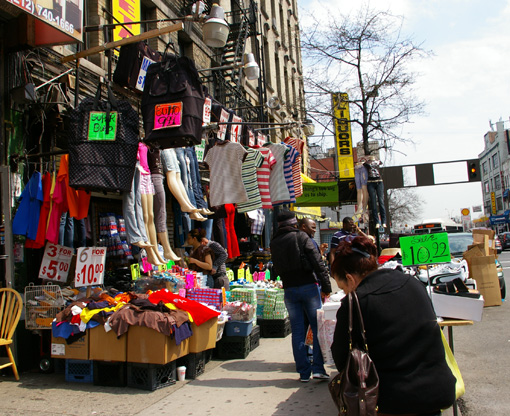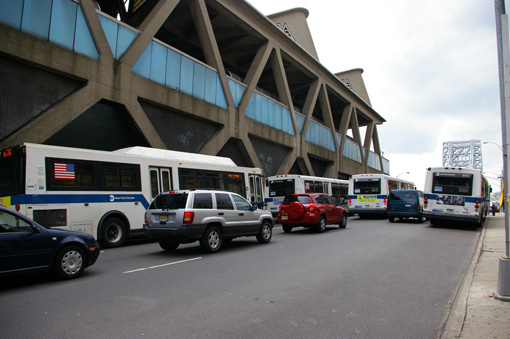In the Heights: City Aims to Make 181st a Complete Street

Buses and trucks jockey for position on 181st Street in Washington Heights
Less parking; safer conditions for pedestrians and cyclists; fewer buses; improved traffic enforcement; designated commercial loading zones; control over street vendors; more parking.
Those were among the top suggestions offered to DOT staff and consultants last Thursday at a forum for planned improvements to 181st Street — one of 14 city corridors chosen for an overhaul under the federal Congestion Mitigation and Air Quality Program (CMAQ). And 181 is indeed ripe for a revamp, as attested to by the roughly 35 Northern Manhattanites who made it to Community Board 12 headquarters in Washington Heights for the first in a year-long series of project meetings.
The Heights’ main drag is victim to a confluence of congestion-inducing conditions: it connects directly to the Bronx via the (free) Washington Bridge to the east, and indirectly to New Jersey via the George Washington Bridge to the west; it’s part of a local truck route; five bus lines run along most of its length. The street is also a commercial corridor without loading zones, where vendors and space-hogging retailers obstruct pedestrian traffic that flows at a volume rivaling some areas of Midtown.

Street vendors and retailers dominate the sidewalks
Here are some common complaints cited by residents at the forum:
- Untenable conditions for pedestrians, including short walk signal times and intersections where drivers do not yield the right-of-way
- Crowded sidewalks caused by street vendors and other clutter
- Inordinate number of buses, many of which use 181 and nearby streets as staging areas
- Rampant double parking
- NYPD: reckless driving by police; lack of enforcement of double parking and other traffic violations; illegal parking by officers around the 34th Precinct station house two blocks to the north
And here are (often overlapping or conflicting) suggestions for improvement:
- Remove all on-street parking east of Broadway and replace with loading zones
- Eliminate private on-street parking between 8:00 a.m. and 6:00 p.m.; have businesses validate for garage parking
- Remove all parking from 181 and replace with muni-metered loading zones
- Tow double-parked vehicles
- Institute a shuttle bus or trolley route to the Bronx
- Adjust bus routes to reduce bus congestion
- Daylight corners and add turn lanes
- Remove newsstands on "tight corners"
- Install red light cameras
- Make the street safer for cyclists
DOT’s stated intention is to make 181 a complete street, and while residents on hand seemed sympathetic to pedestrian and cyclist issues, the buck clearly stopped with residential parking. A common refrain was that there is not enough vehicle storage in Washington Heights, and that no residential on-street spaces should be sacrificed, even to improve traffic flow. This sentiment is likely to carry a lot of weight with CB 12, which will judge DOT’s ultimate proposal in December.
Staffers said they were expecting about 100 people at this forum, so there will probably be plenty of room for way-uptown livable streets advocates at the next one (date TBD). There will also be a 181st Street "walk-through" in the near future, with DOT, consultants and residents touring the corridor together. Streetsblog will keep you posted.

Buses park and idle near the George Washington Bridge terminal
Photos: Brad Aaron

